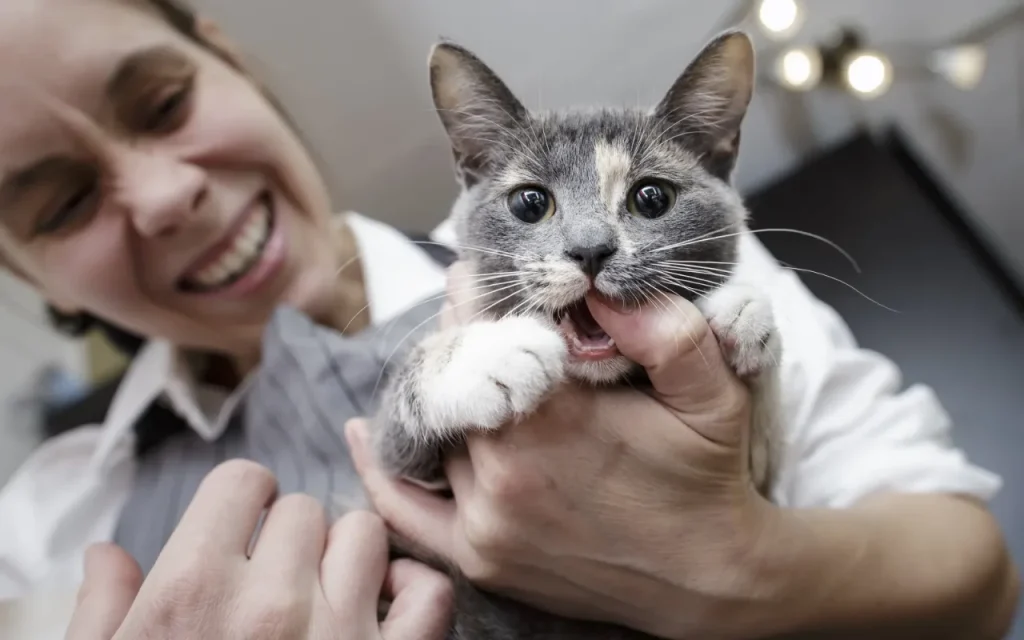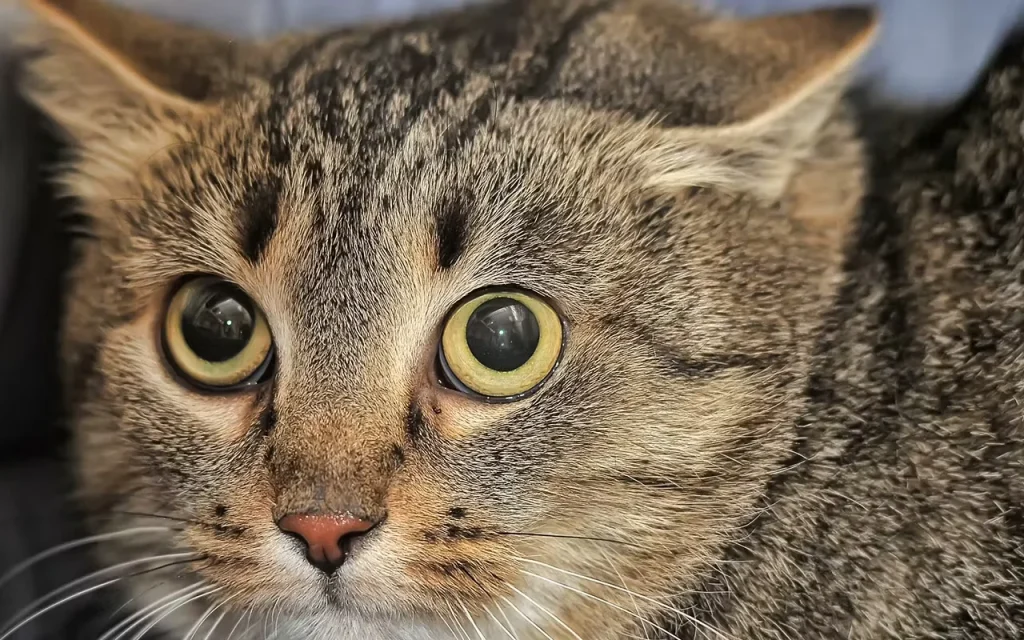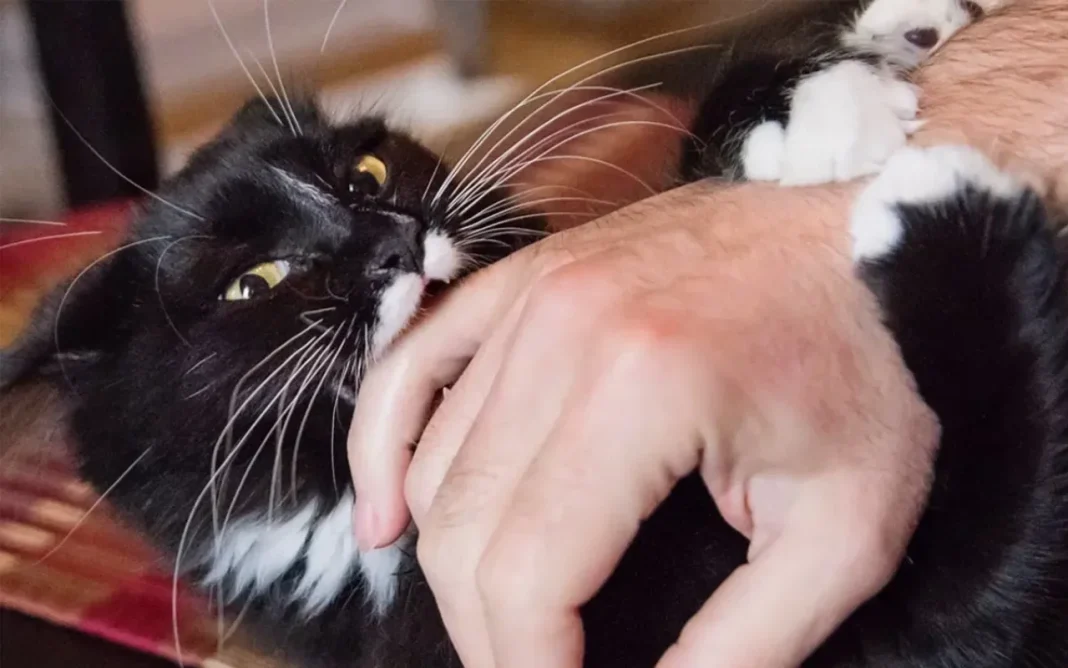You’re having a lovely, quiet moment with your cat, right? They’re purring like a tiny tractor, maybe even kneading away on your lap like they’re making the world’s best biscuits. And then, out of nowhere – a little nip! It wasn’t an angry bite, not really, but it sure wasn’t a lick either. If this scenario sounds familiar, welcome to the wonderfully perplexing world of the cat “love bite.” It’s one of those quirky little things our feline friends do that can leave us humans feeling a delightful mix of affection and, let’s be honest, a tiny bit confused. “If you adore me so much,” we wonder, “why the teeth?”
As a vet, I can tell you, you’re absolutely not the first person to ponder this! These little nips, often quite gentle but sometimes just a tad sharper than we’d prefer, are definitely a form of cat communication. But what exactly are they trying to say? When we’re talking about those classic “love bite” scenarios, it’s very rarely about true aggression. It’s usually a much more subtle, layered message, all wrapped up in a furry, slightly toothy package.
So, let’s try and unravel the mystery behind why your cat might give you a little nibble, take a peek into the vet-verified reasons for this behavior, and figure out what they might just be trying to tell you.
First Off, What IS a “Love Bite” (and What’s It Definitely NOT)?
Before we go any further, it’s super important to know the difference between what we generally call a “love bite” or an “inhibition bite,” and other kinds of bites that have very different meanings.
- The Classic “Love Bite” or Nibble: This is usually a pretty quick, relatively gentle nip. Often, it doesn’t even break the skin, or only just barely. You’ll typically see it happen when you’re petting your cat or sharing a quiet, bonding moment, and your cat seems otherwise totally relaxed and happy. They might even keep purring or rubbing against you right after. You generally won’t see any other aggressive signals like hissing, ears plastered back, or a tail that’s lashing around angrily.
- When It’s Not Really a Love Bite:
- Playtime Roughhousing: This is super common with kittens and younger cats who are still learning the ropes about how hard is too hard. These bites can be a bit more ouchy and are all part of their energetic, tumble-around play. Your hands and feet can easily become “practice prey” in these games!
- The “Okay, That’s My Limit!” Bite (Overstimulation): Ever been stroking your cat, they’re lapping it up, and then, as if a switch flips – BAM! – teeth? Some cats just have a certain threshold for how much petting they can handle. One minute it’s bliss, the next it’s all a bit too much for their senses. That bite is their (often rather sudden) way of saying, “ENOUGH NOW, PLEASE!” And usually, there are little warning signs before this happens, which we’ll chat about.
- A “Scaredy Cat” or Defensive Bite: A cat who’s frightened or feels threatened will bite to protect themselves. This kind of bite usually comes with really clear signs of fear – they might be crouching low, hissing, growling, with their ears flat against their head and their pupils like big black saucers.
- An “Ouch, That Hurts!” Bite: If your cat is in pain and you accidentally touch a sore spot, they might bite out of pure reflex.
For our little chat today, we’re really focusing on those gentler nips that seem to come out of the blue during what feels like a perfectly loving moment.
So, Why the Gentle Nips? A Vet’s Look into Your Cat’s Mind

Why on earth do our otherwise sweet and cuddly cats sometimes feel the need to use their teeth when they seem to be feeling affectionate? Here are some of the main reasons that vets and cat behavior folks believe are behind these little nibbles:
- It’s Like an Over-Enthusiastic Grooming Session:
- Here’s the Thinking: In the world of cats, mother cats groom their tiny kittens with lots of licks and often some very gentle nips. And adult cats who are really bonded will frequently groom each other – vets call this “allo-grooming” – and yes, that can include a bit of light nibbling too. So, when your cat gives you a little nip while they’re purring and rubbing against you, they might just be extending this very natural grooming behavior to you, their much-loved (if slightly less furry) family member. As a vet might put it, “They’re basically saying, ‘You’re one of my special tribe, and I care for you.’ Sometimes, that caring just involves a tiny bit more tooth than we humans are used to!” They probably just haven’t quite worked out that our skin is a tad more delicate than another cat’s fur.
- “I’m Loving This, But… It’s Getting a Bit Intense!” (A Gentle Hint of Overstimulation):
- Here’s the Thinking: This is a really, really common one. Your cat is genuinely enjoying all the petting, truly! But their little sensory system might be starting to feel just a tiny bit overloaded. That very gentle nip can often be their first, softest way of trying to say, “Okay, that’s lovely, but it’s almost enough now, perhaps we could slow down or stop pretty soon?” It’s like their polite little warning shot before they feel they have to escalate to a more obvious “HEY, I SAID STOP!” bite if the petting continues past their personal comfort zone. Cats all have different limits for how much physical touch they enjoy. Some could be petted for hours on end, while others are good after just a few minutes. That little nip is often their subtle way of communicating, “My nerves are starting to tingle a bit here, let’s just ease off a touch, shall we?” If you miss this gentle hint, that’s when you might get a less gentle one.
- A Clever Way to Get Your Attention or Maybe Start a Game:
- Here’s the Thinking: Sometimes, a cat learns pretty quickly that a little nip gets a definite reaction from you. Maybe they want you to keep petting them if you’ve stopped, or perhaps they’re feeling a bit playful and are trying to get you to join in. If you’ve ever responded to a little nip by then giving them more attention (even if that attention is you saying “No, don’t bite!”), they might have just learned a new trick: “Aha! Using my teeth makes the human focus on me!” Cats are smart little creatures, after all. If a particular behavior results in something they like – more attention, a bit of playtime – they’re quite likely to try it again. That little so-called “love bite” might actually be a “play with me right now bite” or a “hey, why did you stop petting me bite” in disguise, all based on what they’ve figured out works to get your attention.
- A Little Hangover from Their Kitten Days (Teething & Exploring):
- Here’s the Thinking: Kittens, as you probably know, explore absolutely everything with their mouths. And when they’re going through that teething phase, nibbling on things can be quite soothing for their sore gums. Now, if a cat didn’t get the full lesson on “bite inhibition” from their mum and littermates when they were tiny (that all-important lesson on how hard is too hard to bite during play), some of this mouthing and nibbling behavior might just carry over into their adult life as a way they interact with you. For some grown-up cats, especially if they were perhaps separated from their litter a bit on the early side, these very gentle nips might just be a lingering exploratory behavior or even a way they self-soothe. They’re really not trying to hurt you, just interacting in a way that felt perfectly natural to them when they were a little fluffball.
- It’s Just… Them! (Part of Their Unique Personality & How They “Talk”):
- Here’s the Thinking: Just like us humans, every cat has their own quirky little personality. Some are just naturally more “mouthy” or tactile than others in how they show affection or try to get you to interact. For some really well-socialized and clearly affectionate cats, a very, very gentle, inhibited little nip now and then is simply part of their unique way of expressing themselves within a relationship where they feel completely safe and loved.
Reading the Whole Picture: Their Body Language is Spilling the Beans!

To really understand the true message behind that little nip, you need to become a bit of a detective and pay close attention to your cat’s entire body language. This will help you tell the difference between a truly gentle, affectionate love nibble and a “Hey, I’m about to get a bit cross here!” warning signal.
- Clues Your Cat is Feeling Relaxed and Loved-Up (often goes with those super gentle nips):
- Their body will look soft and loose, no tension there.
- You’ll probably hear that lovely purr rumbling away.
- They might give you those slow, sleepy blinks.
- Their ears will be pointing forward or just slightly off to the side, looking all natural and relaxed.
- Their tail might be still, or just swishing very gently and slowly.
- They might even be kneading away with their paws (“making biscuits” as we often call it!).
- Clues Your Cat is Getting a Bit Overstimulated or Irritated (Warning! A less gentle bite might be coming, or this is their “please stop” signal):
- Watch that tail! Is it starting to twitch sharply at the end, or even thump a bit on the floor or your lap?
- You might see their skin ripple or twitch along their back – a classic sign of “too much.”
- Are their ears starting to flatten out to the sides, or rotate backward?
- Look at their pupils – are they suddenly getting much larger (dilating)?
- Does their body feel a bit tense or rigid under your hand all of a sudden?
- Have they stopped purring abruptly, or is the purr suddenly very loud and intense (which can sometimes, confusingly, be a sign of stress, not just pleasure)?
- You might see a quick, darting flick of their head towards your hand right before they make contact with their teeth.
- A low growl or a hiss? Well, that’s a very clear “I am not happy, back off now!”
So, How Should You Handle Those Affectionate Little Chomps?
How you react to these little nips can really shape whether the behavior continues, gets more intense, or gradually fades away.
- If It’s a Truly GENTLE, Occasional Nibble That Honestly Doesn’t Bother You: Some people genuinely don’t mind those incredibly soft, inhibited little nips from their cats and just see it as one of their cat’s quirky ways of showing affection. If it doesn’t actually hurt you and never, ever breaks the skin, you might just choose to accept it as part of your unique bond with your cat.
- If You Want to Gently Discourage Nipping (Even the Soft Ones):
- Try Not to Snatch Your Hand Away Super Fast: This can sometimes trigger their prey drive and make them bite down harder or try to grab onto your hand.
- Make a Soft, Surprising “Ouch!” Sound: Not a big yell that will scare them, but a quick, slightly high-pitched sound can often be enough to signal that it was a bit too much for your delicate human skin.
- The Instant You Feel Teeth, Stop All Petting/Interaction: Freeze for a second, and then very slowly withdraw your hand. The clear message you want to send is: “When you use your teeth on me, all the nice stuff, like petting and attention, stops immediately.” Give them a little “time out” from your attention for a minute or two.
- Offer a Toy Instead (Redirect That Energy!): If you suspect the nip is their way of trying to get you to play, keep a fun toy handy. Before they get a chance to nip, or right after you’ve paused attention from a nip, try to redirect all that energy onto the toy. And a golden rule: never, ever offer your hands, fingers, or feet as playthings!
- If You Think It’s Overstimulation Kicking In:
- Learn Their “Petting Quota”: Pay really close attention to their body language clues we talked about. Try your best to stop petting before they start showing those little signs of irritation. So many cats have a definite limit to how much petting they enjoy at one time. And often, common spots that can quickly lead to overstimulation are the base of their tail and their tummy. It’s usually safer to stick to petting their head, their cheeks, and under their chin, and keep the sessions a bit shorter.
- The “Cool Down” Break from Petting: If you see that tail starting to twitch or their skin ripple, stop all petting right away and just let them chill out for a bit.
- Super Important: NEVER Punish Your Cat for Biting: Getting physical with your cat (like hitting them, scruffing them, or yelling aggressively) when they bite will only achieve one thing: it will make them afraid of you. It can seriously damage the trust and bond you have, and it can even make aggression worse. They simply won’t understand why you’re punishing them; they’ll only learn that you have suddenly become scary and unpredictable.
When a Little Nip Might Be a Sign of Something More: Time to Chat with Your Vet
While most of those little “love bites” are relatively harmless communication attempts, it’s a good idea to get in touch with your vet if:
- The bites are actually breaking your skin on a regular basis.
- The biting seems to be happening more often or is getting noticeably more intense.
- Those “love bites” are starting to be accompanied by other, more clearly aggressive signs (like hissing, growling, or ears pinned flat).
- You’re just finding it really hard to manage the behavior, or you’re simply worried that it’s not normal.
And look, if things feel a bit beyond what you can manage, or if you’re just plain worried something isn’t right – maybe those nips are getting harder or more frequent – your own vet is always your best first port of call. They can give your kitty a good once-over to make sure there isn’t some sneaky pain or health niggle making them cranky. And if it is more of a behavior puzzle, they can share some extra tips, or even point you towards some really brilliant folks – proper cat behavior specialists, you know – who can dig even deeper if things are super tricky.
So, What’s the Real Deal with These Quirky Cat Compliments? When all’s said and done, those little ‘love bites’? They really are one of the more fascinating, if sometimes head-scratching, ways our amazing cat buddies try to ‘talk’ to us. It’s like they have this whole secret language! But the more you tune into their little body language quirks, get a feel for what might be going on in their furry heads when they do it, and then respond with a bit of gentle understanding, the better you’ll get at figuring out their unique little messages. It’s all part of that incredible, ever-evolving adventure of sharing your life with these truly wonderful, complex, and oh-so-lovable creatures, isn’t it?











